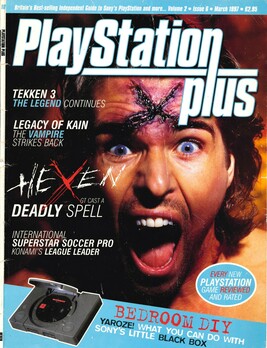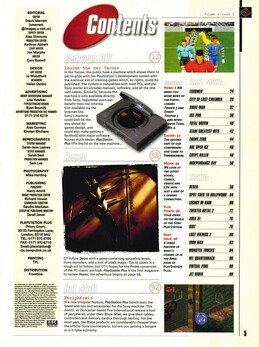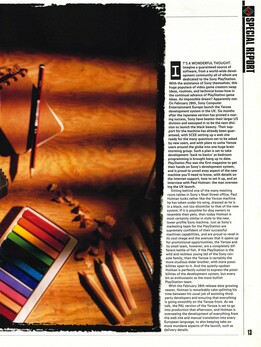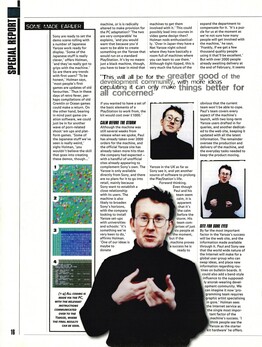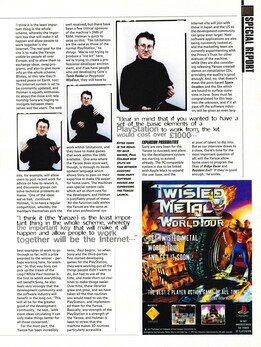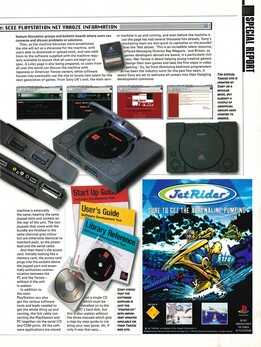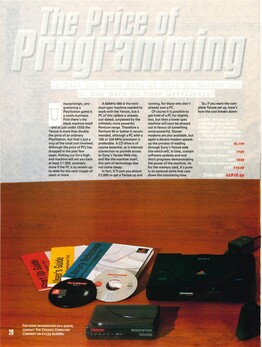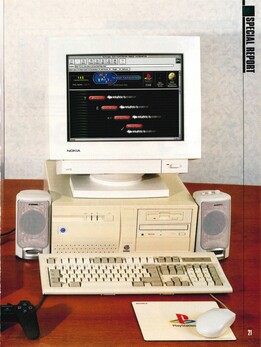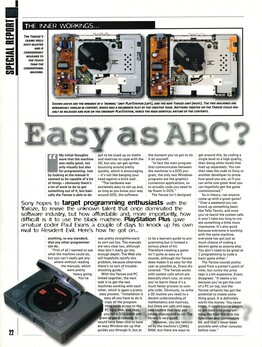
Bedroom DIY - Inside the new Yaroze.
March 04, 2023, at 12:18 PM (0 comments)
Title: Bedroom DIY - Inside the new Yaroze. Author: mgarcia Date: 2023-03-04 12:18 +0100 Tags: Media, Articles Comments: Open
|  |
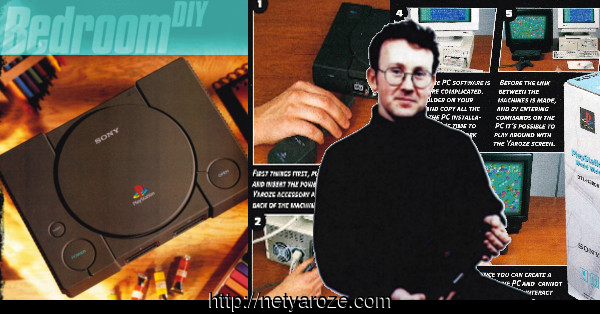
Article transcribed from: PlayStation Plus Vol 2 Issue 6, 1997, with minor corrections and annotation.
PDF of this article is available here.
Staff writer: Jon Murphy.
Writer: Gary Russell.
Art editor: Jo Woodford.
Designer: Helen Danby.
Photography: Mike Harding.
Bedroom DIY - Inside the new Yaroze.
Page 5, Contents.
In the Yaroze, the public have a machine which allows them to get to grips with the PlayStation's development system with the eventual aim of creating games which, by rights, could be published. The system is compatible with most PCs, and the Sony starter kit includes manuals, software, and all the relevant cables. Similarly, because the machine is only available directly from Sony, registered users can benefit from the information available via the Internet site. Sony's machine could well be the way ahead for games design, and could also make getting a foothold with major software houses much easier. PlayStation Plus lifts the lid on the new machine...
Pages 12 & 13.
Bedroom DIY.
IT'S A WONDERFUL THOUGHT. Imagine a guaranteed source of software, from a world-wide development community all of whom are dedicated to the Sony PlayStation. With the assistance of Sony themselves, this huge populace of video game creators swap ideas, routines, and technical know-how in the continual advance of PlayStation game ideas. An impossible dream? Apparently not. On February 28th, Sony Computer Entertainment Europe launch the Yaroze development system in the UK. Six months after the Japanese version has proved a roaring success, Sony have beaten their larger US division and swooped in to be the next division to launch the black beauty. Their support for the machine has already been guaranteed, with SCEE setting up a web site ready for the many questions set to be asked by new users, and with plans to unite Yaroze users around the globe into one huge brain storming group. Such a plan is set to take development 'back to basics' as bedroom programming is brought bang up to date. PlayStation Plus was the first magazine to get their hands on Sony's development system, and is proud to unveil every aspect of the new machine you'll need to know, with details on the Internet support, how to set it up, and an interview with Paul Holman: the man overseeing the UK launch.
Sitting behind one of the many meeting room tables in Sony's Noel Street office, Paul Holman looks rather like the Yaroze machine he has taken under his wing, dressed as he is, in black, not too dissimilar to that of the new system. If it is possible for dog owners to resemble their pets, then today Holman is most certainly similar in style to the new, lower profile Sony machine. Just as Sony's marketing team for the PlayStation are supremely confident of their successful machines capabilities, and are proud to revel in its cool image and the avenues that it opens up for promotional opportunities, the Yaroze and its small team, however, are a completely different kettle of fish. If the PlayStation is the wild and reckless young lad of the Sony console family, then the Yaroze is certainly the more studious elder brother, with more possibilities open to it. And the quietly-spoken Holman is perfectly suited to express the possibilities of the development system, but every bit as enthusiastic as the more bullish PlayStation team.
With the February 28th release date growing nearer, Holman is remarkably calm splitting his time between his usual job of assisting third-party developers and ensuring that everything is going smoothly on the Yaroze front. As we talk, the PAL version of the Yaroze is set to go into production that afternoon, and Holman is overseeing the development of everything from the web site and manual translation into every European language, to also keeping tabs on more mundane aspects of the launch, such as delivery details.
Pages 14 & 15.
Humble Beginnings.
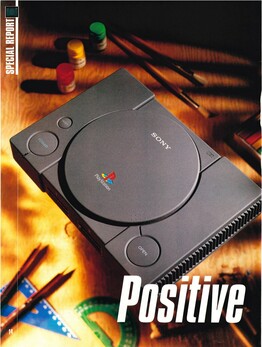
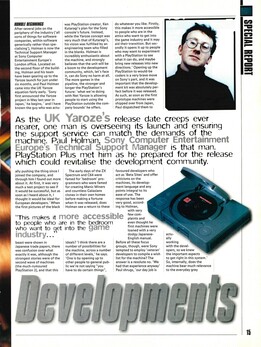
Image of Net Yaroze PlayStation on a timber desk with drawing and painting items - Positive Developments.
As the UK Yaroze's release date creeps ever nearer, one man is overseeing its launch and ensuring the support service can match the demands of the machine. Paul Holman, Sony Computer Entertainment Europe's Technical Support Manager is that man. PlayStation Plus met him as he prepared for the release which could revitalise the development community.
After several jobs on the periphery of the industry ('all sorts of things for software companies, within software generically rather than specialising'), Holman is now the Technical Support Manager at Sony Computer Entertainment Europe's London office. Located on the second floor of the building, Holman and his team have been gearing up to the Yaroze launch for just under six months, and Paul Holman came into the UK Yaroze equation fairly early. 'Sony first announced the Yaroze project in May last year in Japan,' he begins,' and I have known the guy who was actually pushing the thing since I joined the company, and through him I found out more about it. At first, it was very much a test project to see if it would be successful, but as soon as I heard about it, I thought it would be ideal for European developers.' When the first pictures of the black beast were shown in Japanese trade papers, there was confusion over what exactly it was, although the strongest stories were of the second wave of machines (the much-rumoured PlayStation 2), and that this was PlayStation creator, Ken Kutaragi's plan for the Sony console's future. Instead, while the Yaroze concept was very much that of Kutaragi's, his vision was fulfilled by an engineering team who filled in the blanks. Holman is incredibly enthusiastic about the machine, and strongly believes that the unit will be a boom to the development community, which, let's face it, can do Sony no harm at all. The more games in the pipeline, the stronger and longer the PlayStation's future: 'what we're doing with Net Yaroze is allowing people to start using the PlayStation outside the company bounds' he offers.
The early days of the ZX Spectrum and C64 were famed for 'bedroom' programmers who were famed for creating Manic Miners and countless Galaxians clones in their own homes before making a fortune when it was released, does Holman see a return to these ideals? 'I think there are a number of possibilities for the machine, across a number of different levels,' he says. 'One is by opening up to other people, to general public, we're not saying "you have to do certain things", do whatever you like. Firstly, this makes it more accessible to people who are in the attics who want to get into the game industry and it may aid their transition. But secondly it opens it up to people who may want to experiment with a PlayStation to see what it can do, and maybe bring new releases into new directions.' Opening up the PlayStation to would-be coders is a very brave move on Sony's part, and it was important that the development kit was absolutely perfect before it was released. As such, as soon as the first prototype machines were shipped over from Japan, Paul dispatched them to favoured developers who act as 'Beta Sites' and offer criticisms on the machines, its development language and any points integral to its ease of use. The response has been very good, according to Holman, with very few complaints and even thought the first machines were loaned with a very dodgy Japanese-English manual. Before all these focus groups, though, were Sony tempted to employ 'veteran' developers to compile a wish list for the machine? The answer is a resolute no. 'We had that experience anyway' Paul shrugs, 'our day job is with the developers, so we knew the important aspects to get right in this system.' So, internally, does the machine bear much relevance to the everyday grey machine, or is it radically altered to make provision for the PC adaptation? 'The two are very comparable' he explains, 'and you would want that because you'd want to be able to create something on the Yaroze that would run on a standard PlayStation. It's by no means just a black machine, though, you have to bear in mind that if you wanted to have a set of the basic elements of a PlayStation to work from, the kit would cost over £1000 (British Pounds).'
"This makes it more accessible to people who are in the bedroom who want to get into the game industry..."
Pages 16 & 17.
Some Made Earlier.
Sony are ready to set the demo scene rolling with a number of Japanese Yaroze work ready for display. 'Some of the Japanese stuff is really clever,' offers Holman, 'and they've really got to grips with the machine.' So are there any trends with first users? 'To be honest,' Holman says, 'most people's first games are updates of old favourites.' Thus in these days of retro fever, perhaps compilations of old Gremlin or Ocean games could make a return. On the other hand, bearing in mind past game creation software, we could just be in for another wave of porn-related shoot 'em ups and platform games. 'Some of the Japanese stuff we've seen is really weird,' sighs Holman, 'you wouldn't believe the skill that goes into creating these demos, though...'
(1-4) ALL CODING IS MADE VIA THE PC, WITH THE RELEVANT INSTRUCTIONS COMMUNICATED OVER TO THE YAROZE, WHERE THE FINAL RESULTS CAN BE SEEN.
"This will all be for the greater good of the development community, with more ideas circulating it can only make things better for all concerned."
Calm Before The Storm.
Although the machine was still several weeks from release when we spoke, Paul has already taken over 2000 orders for the machine, and the official Yaroze site has already taken more hits than the company had expected - with a handful of unofficial sites already appearing to complement Sony's own. The Yaroze is only available directly from Sony, and there are no plans for it to go into retail, mainly because Sony want to establish a close relationship with its users. The machine is also likely to broaden Sony's horizons, with the company looking to install Yaroze set-ups with universities and schools: 'it's something we're very keen to do,' affirms Holman. 'One of our ideas is maybe to donate machines to get them involved with it.' This could possibly lead into courses in video game design then? Holman nods enthusiastically. 'Over in Japan they have a Net Yaroze night school where they have basically a room full of machines where you can learn to use them.' Although tight-lipped, this is very much the future of the Yaroze in the UK as far as Sony see it, and yet another source of software to prolong the PlayStation's life. Forward thinking.
Even though Paul and his team seem calm, it is apparent that it's the calm before the storm. His team comprises of just six people at the moment, but if the machine proves a success he is ready to expand the department to compensate for it. 'It's a puzzle for us at the moment as we're not sure how many people will get involved with the machine,' he says. 'Frankly, if we get a few thousand quality people using it that'll be excellent.' But with over 2000 people already awaiting delivery at the end of February, it seems obvious that the current team won't be able to cope. Paul's team covers every aspect of the machine's launch, with two long-term Yaroze users drafted in for queries, and another dedicated to the web site, keeping it updated with all the latest information. The remainder oversee the production and delivery of the machine, and the everyday tasks needed to keep the product moving.
Site for sore Eyes.
By far the most important factor in the Yaroze's success will be the web site, and the information made available through it. Paul and Sony see that the world wide nature of the Internet will make for a global user group who can swap ideas, and place new information regarding routines on bulletin boards. It could also add a band-style influence to the supposedly anorak-wearing development community. We can imagine it now 'programming team requires graphic artist specialising in gore.' Holman sees the Internet service as the single most important factor of the machine's success. 'I think people see the Yaroze as the starter kit hardware' he offers.
'I think it is the least important thing in the whole scheme, whereby the important key that will make it all happen and allow people to work together is the Internet. The real goal for the site is to make the Yaroze usable by people all over Europe, and to allow them to exchange ideas, swap programs, and also to give more info on the whole scheme.' Blimey, at this rate they'll spread peace on Earth, too! The Internet system is set to be constantly updated, and Holman is equally enthusiastic about the close-knit relationship Sony are hoping to instigate between themselves and the users. The web site, for example, will allow users to post recent work for advice on how to rework it, and discussion groups can solve technical problems en masse. 'One of the ideas we've had,' continues Holman, 'is to have a regular competition, whereby the members themselves pick the best examples of work to go through so far, with a prize awarded to the winner - perhaps working here, for example.' So that way Sony can pick up the cream of the crop? While Paul Holman is the first to admit everything will benefit Sony, he also feels very strongly that the development community and the software industry will benefit in the long run. 'This will all be for the greater good of the development community,' he says, 'with more ideas circulating it can only make things better for all those concerned.'
For the most part, the Yaroze has been incredibly well received, but there have been a few critical opinions of the machine's 2Mb of RAM. Holman is quick to seize on this: 'The limitations are the same as those of the normal PlayStation,' he shrugs. 'We're not trying to produce a "kid kit" here, we're trying to create a professional developer environment, and if we have people who are developing Core's Tomb Raider or Psygnosis' Wipe-Out, they still have to work within limitations, and they have to make games that work within the 2Mb available. One area where the Yaroze does score well, though, is through its development language which allows Sony to pass on their expertise to make life easier for home users. The machines uses special system calls which act as short cuts for the developers, and Holman is justifiably proud of these. 'All the function calls within the Yaroze are the same as the ones professional systems,' Paul begins, 'so when Sony and the third-parties first started developing games for the PlayStation, they were working out all the things people didn't want to do, but had to use all the time, and made short cut routines to make things easier. Over time, these libraries grew and grew, and we have taken all the that routines you would need to use the PlayStation, and implemented them for the Yaroze.' Basically, any strength of the PlayStation is a strength of the Yaroze, and Holman is keen to stress that the machine makes 3D routines particularly accessible.
"Bear in mind that if you wanted to have a set of the basic elements of a PlayStation to work from, the kit would cost over £1000(British Pounds)..."
AFTER YEARS IN THE INDUSTRY BACK WATERS, PAUL HOLMAN NOW SPLITS HIS TIME BETWEEN ASSISTING THIRD-PARTY SOFTWARE HOUSES AND SUPERVISING THE YAROZE LAUNCH.
Expansion Possibilities.
Sony are very keen for the Yaroze to succeed, and plans for the development system are starting to extend already. The PC compatible system is due to be linked with Apple Macs to expand the user base, and the Internet site will join with those in Japan and the US so the development community can grow even larger. New software applications are also being constantly looked at, and the marketing team are currently experimenting with the Prince's Trust for other avenues of the machine, while they are also considering releasing Yaroze-created demos on compilation CDs, providing the quality is good enough. And, no, that doesn't mean the porn-based Space Invaders and the like which are bound to surface sometime in June. Sony must be congratulated for this leap into the unknown, and if it all pays off the software industry will be given an even larger pool of talent to dip into. But as our interview draws to a close, there's time for the most important question of all; will the Yaroze allow home users to program the likes of Ridge Racer and Resident Evil? 'If they're good enough,' he smiles.
"I think it (the Yaroze) is the least important thing in the whole scheme, whereby the important key that will make it all happen and allow people to work together will be the Internet..."
Pages 18 & 19.
The Installation Game.
Picture the scene: you've just bought a brand new PC worth £2,000 (British Pounds), your Yaroze has just arrived by courier and now both machines are sitting next to each other on the desk. But what do all of the leads and CDs do? follow this step-by-step set-up guide and everything will become clear.
- FIRST THINGS FIRST, PLUG THE YAROZE INTO THE TELEVISION OR MONITOR AND INSERT THE POWER LEAD. NEXT, TAKE THE PC LINK CABLE FROM THE YAROZE ACCESSORY PACK AND SLOT IT INTO THE SERIAL I/O SOCKET ON THE BACK OF THE MACHINE.
- NEXT INSERT THE 9-PIN (RS232) PLUG INTO THE COM PORT ON THE REAR OF THE PC. PLEASE NOTE THAT, IDEALLY, THE PC NEEDS THREE COM PORTS - ONE FOR THE YAROZE, ONE FOR A MOUSE AND ONE FOR A MODEM.
- WITH THE YAROZE CONNECTED TO THE PC, OPEN THE MACHINE AND INSERT THE BLACK PLAYSTATION CD THAT COMES WITH THE ACCESSORY PACK. ALSO INSERT THE ACCESS CARD AND, IF YOU HAVE ONE, A MEMORY CARD.
- INSTALLING THE PC SOFTWARE IS SLIGHTLY MORE COMPLICATED. CREATE A FOLDER ON YOUR HARD DISK AND COPY ALL THE DATA FROM THE PC INSTALLATION CD. NOW IT'S TIME TO READ THE MANUAL TO WORK OUT WHAT'S GOING ON.
- BEFORE THE LINK BETWEEN THE MACHINES IS MADE, AND BY ENTERING COMMANDS ON THE PC, IT'S POSSIBLE TO PLAY AROUND WITH THE YAROZE SCREEN.
- WITH A LOT OF TIME AND PATIENCE YOU CAN CREATE A BASIC GAME DEMO. IT'S STORED ON THE PC AND CANNOT BE BURNED ONTO A CD, ALTHOUGH YOU CAN INTERACT WITH THE CODE USING THE PLAYSTATION JOYPAD.
Netscape: SCEE PlayStation Net Yaroze Information.
Holman's plans to make use of the Internet as a constant source of information are already in place, with the bare skeleton of a Yaroze site up and running. With the machine still a few weeks from release, the site currently deals with the most basic of questions, with an FAQ (Frequently Asked Questions) page listing virtually every possible question relating to the system. However, while this is fine for tiding over the users until the machine is out, the site is set to explode into virtually every direction imaginable after the February 28th release. Holman and his team plan to use the web site to answer every problem imaginable, and it will also feature discussion groups and bulletin boards where users can converse and discuss problems or solutions.
Then, as the machine becomes more established, the site will act as a showcase for the machine, with users able to download or upload work, and new additions to the software supplied with the machine regularly available to ensure that all users are kept up to spec. A Links page is also being prepared, so users from all over the world can discuss the machine with Japanese or American Yaroze owners, while software houses may eventually use the site to locate new talent for the next generation of games. From Sony UK's end, the main server machine is up and running, and even before the machine is out the page has had several thousand hits already. Sony's marketing team are also quick to capitalise on the possibilities the Net allows. 'This is an incredible talent resource,' offered Managing Director Ray Maguire, 'and Britain, as games developers abroad are aware, is a particularly rich vein. Net Yaroze is about helping young creative gamers design their own games and take the first steps in video gaming.' So, far from dismissing bedroom programmers as has been the industry norm for the past few years, it seems Sony are set to welcome all comers into their fledgling development commune.
THE OFFICIAL YAROZE SITE IS UPDATED BY SONY ON A REGULAR BASIS, BUT ALREADY A COUPLE OF UNOFFICIAL GROUPS HAVE STARTED TO EMERGE.
What You Get.
£549 (British Pounds) is a lot of money, especially when a standard PAL PlayStation costs just under £200. Unsurprisingly then, you get more than just a smart looking black PlayStation for the Yaroze's sizable price tag. In fact you get everything needed to start programming your own PlayStation game, apart from the PC and a basic knowledge of the programming language C.
The machine itself looks slick. Boasting a cool charcoal grey finish as opposed to the standard drab exterior, the surface of the machine is textured, giving it a feeling of quality rather than plastic tackiness. Otherwise the machine is externally the same, bearing the same joypad slots and sockets on the rear of the unit. The two joypads that come with the bundle are finished in the same charcoal grey colour but are otherwise identical to standard pads, as the power lead and the aerial cable.
And then there's the access card. Initially looking like a memory card, the access card plugs into the sockets above the joypad port and essentially authorises communication between the PC and the Yaroze - without it the unit is useless.
In addition to the main PlayStation you also get the various software tools and leads needed to get the whole thing up and running, the link cable connecting the PlayStation and PC together via the serial I/O and COM ports. All the software applications are stored on a single CD which must be installed on to the PC's hard disk, but this is also useless without the three manuals which give a step-by-step guide to creating your own game. Ah, if only it was that easy...
SONY STRESS THAT THE SOFTWARE SUPPLIED IS JUST THE 'STARTER KIT' WITH IMPORTANT UPDATES AVAILABLE VIA THEIR YAROZE WEB SITE.
Pages 20 & 21.
The Price of Programming.
So just how much does it cost to become one of the band of home developers?
Unsurprisingly, programming a PlayStation game is a costly business. First there's the black machine itself - and at just under £550 the Yaroze is more than double the price of an ordinary PlayStation, but that's just a snip of the total cost involved. Although the price of PCs has dropped in the past few years, forking out for a high-end machine will set you back at least £1,500, probably more if the PC is to remain up-to-date for the next couple of years or more.
A 66MHz 486 is the minimum spec machine needed to work with the Yaroze, but a PC of this calibre is already out-dated, surpassed by the infinitely more powerful Pentium range. Therefore a Pentium 90 or better is recommended, although a PC with a 166 or 200 MHz processor is preferable. A CD drive is of course essential, as is Internet connection to provide access to Sony's Yaroze Web site, and like the machine itself, this sort of technology does not come cheap.
In fact, it'll cost you almost £3,000 (British Pounds) to get a Yaroze up and running, for those who don't already own a PC.
Of course it is possible to get hold of a PC for slightly less, but then a lower spec machine will soon be phased out in favour of something more powerful. Slower modems are also available, but again a decent modem speeds up the process of wading through Sony's Yaroze web site which will, in time, contain software updates and and short programs demonstrating the power of the machine. As for the memory card, it's purely an optional extra that cuts down the translating time.
So, if you want the complete Yaroze set up, here's how the cost breaks down:
200MHZ PENTIUM PC, WITH
- 32MB RAM,
- 12-SPEED CD-ROM DRIVE,
- 17" TRINITRON MONITOR,
- 2MB 3D VIDEO CARD,
- 1.2GB HARD DRIVE AND
- SOUND BLASTER 32 SOUNDCARD.
COST: £2,100 (British Pounds).
33.6KB/S FAX MODEM
COST: £150 (British Pounds).
PLAYSTATION YAROZE
COST: £549 (British Pounds).
PLAYSTATION MEMORY CARD
COST: £19.99 (British Pounds).
TOTAL COST: £2818.99 (British Pounds).
Page 22.
The Inner Workings...
THE YAROZE'S CASING FEELS SHOT-BLASTED AND IS CONSIDERABLY ROUGHER TO THE TOUCH THAN THE CONVENTIONAL MACHINE.
SHOWN ABOVE ARE THE INNARDS OF A 'NORMAL' GREY PLAYSTATION (LEFT), AND THE NEW YAROZE UNIT (RIGHT). THE TWO MACHINES ARE REMARKABLY SIMILAR IN CONTENT, WHICH WAS A DELIBERATE PLOY BY THE CREATIVE TEAM. ANYTHING CREATED on the YAROZE COULD FEASIBLY BE RELEASED AND RUN ON THE ORDINARY PLAYSTATION, HENCE THE NEAR IDENTICAL NATURE OF THE CONTENTS.
Easy as ABC?
Sony hopes to target programming enthusiasts with the Yaroze, to revive the unknown talent that once dominated the software industry, but how affordable and, more importantly, how difficult is it to use the black machine. PlayStation Plus gave amatuar coder Paul Evans a couple of days to knock up his own rival to Resident Evil. Here's how he got on...
My initial thoughts were that the machine was really good, not only visually but also for programming. Just by looking at the manual it seemed to be capable of a lot of things obviously there's a lot of work to do to get something out of it, but basically the Yaroze is able to do anything, to any standard, that any other programmer can do.
"First of all I wanted to see what the machine could do, but you can't really get anywhere without reading the manuals, which were pretty heavy going. You've got to be clued up on maths and matrices to cope with the 3D, but you can get sprites bouncing around pretty quickly, which is encouraging - it's not like banging your head against a brick wall.
"The hardware was extremely easy to set-up and, as long as you know your way around DOS, the software was pretty straightforward to sort out too. The manuals are very clear too, although they don't really go into enough depth. The Web site will hopefully rectify this problem, because otherwise there's no sort of trouble-shooting guide."
With the Yaroze and PC linked together, the next task is to get the two machines working with each other, which is again a pretty easy process. "Installation is easy all you have to do is copy all the programming tools across to the PC hard disk, and then you run a DOS batch program to get it running. It would have been nice to have an easy Window set-up that guides you through it, but at the moment you've got to do it all yourself." "In fact the main program that communicates between the machines is a DOS program, the only two Windows programs are the graphics conversion applications, so to actually code you need to be fluent in DOS."
The Yaroze isn't designed to be a learners guide to programming but is instead a serious piece of kit. Therefore creating a game isn't quite as easy as it sounds, although the Yaroze does makes it as easy for the user as possible as, Evans discovered: "The Yaroze works with system calls which are basically short cuts, so once you've learnt these it's a much faster process to compile code. Obviously, to write a 3D routine you need to have a decent understanding of mathematics and matrices, but there are calls and separate routine that help you rotate objects and so on. The library is very good.
"However, you are restricted by the machine's [2Mb] RAM, but there are ways to get around this, by coding a single level to a high quality, then doing other levels that load up separately. You can then take the code to Sony or another developer to prove how good you are, so if you can write one great level you can hopefully get the game commissioned."
So in theory, can anyone come up with a great game? "Over a weekend you can knock up something basic like Telly Tennis, and once you've learnt the system calls it won't take too long to create something a little more impressive. It's also good because everyone is working with the same machine, everyone has got just as much chance of coding a decent game as anyone else. You don't need to be great at C programming to code a basic game either."
The Yaroze sounds pretty good from a punter's point of view, but surely the price tags is a bit expensive. Evans disagrees: "It seems a lot because you've got the cost of a PC on top, but the Yaroze certainly has got the potential to create something good. It is definitely worth the money. You never know, it could inspire people to get back into programming like they did with the Spectrum and Commodore 64, and that's never been possible with other consoles before now."
End of article.
Original article "Bedroom DIY, Inside the new Yaroze" was from PlayStation Plus Vol 2 Issue 6, 1997:
Staff writer: Jon Murphy.
Writer: Gary Russell.
Art editor: Jo Woodford.
Designer: Helen Danby.
Photography: Mike Harding.
Comments are open.
